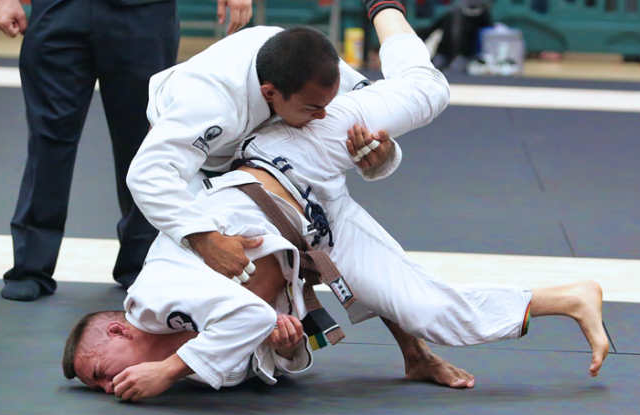IBJJF Tournament Rules
The IBJJF has so many rules that it can be daunting to try to review the handbook yourself the first time. The basics of knowing any tournaments are:
- Point Scoring (Or win conditions for Sub-Only)
- Weight Classes
- Skill Divisions (Belt)
- Submission and Technique Rules
- Equipment Rules
Also note that rules can be different depending if the matches are gi or nogi. Knowing the rules of a Jiu Jitsu tournament can help you to focus on the best possible legal methods of winning your matches.
IBJJF Points Scoring
There are four different ways to score points in IBJJF competition. The scoring is the same for both gi and nogi.
- Takedown 2
- Guard Pass 3
- Sweep 2
- Mount 4
- Back Take 4
IBJJF Mens Weight Classes
- Rooster – under 57.5 kg (under 127 lbs);
- Light feather – above 57.5 kg and under 64 kg (127 – 141.6 lbs);
- Feather – above 64kg and under 70 kg (141.6 – 154.6 lbs);
- Light – above 70kg and under 76 kg (154.6 – 168 lbs);
- Middle – above 76 kg and under 82.3 kg (168 – 181.6 lbs);
- Medium heavy – above 82.3 kg and under 88.3 kg (181.6 – 195 lbs);
- Heavy – above 88.3 kg and under 94.3 kg (195 – 208 lbs);
- Super heavy – above 94.3 kg and under 100.5 kg (208 – 222 lbs);
- Ultra heavy – above 100.5 kg, no upper limit (222 lbs and up);
- Open class – open to all weight classes
IBJJF Womens Female Weight Classes
- Rooster – under 48.5kg (under 107 lbs)
- Light feather – above 48.5kg and under 53.5 kg (107 – 118 lbs);
- Feather – above 53.5 and under 58.5 kg (118 – 129 lbs);
- Light – above 58.5 kg and under 64 kg (129 – 141.6 lbs);
- Middle – above 64kg and under 69 kg (141.6 – 152.6 lbs);
- Medium heavy – above 69 and under 74 kg (152.6 – 163.6 lbs);
- Heavy – above 74 kg and under 79.3 kg (163.6 – 175 lbs);
- Super Heavy – above 79.3 kg
- Open class – open to all weight classes
Female No-gi Weight Classes
- Rooster – under 46.7kg (under 103 lbs);
- Light feather – above 46.7kg and under 51.7 kg (103 – 114 lbs);
- Feather – above 51.7 and under 56.7 kg (114 – 125 lbs);
- Light – above 56.7 kg and under 61.6 kg (125 – 136 lbs);
- Middle – above 61.6kg and under 66.7 kg (136 – 147 lbs);
- Medium heavy – above 66.7 and under 71.6 kg (147 – 158 lbs);
- Heavy – above 71.6 kg and under 76.6 kg (158 – 169 lbs);
- Super Heavy – above 76.6kg;
- Open class – open to all weight classes
IBJJF Worlds
The International Brazilian Jiu-Jitsu Federation (IBJJF) has 22 age divisions for competitors between 4 years old and 61 years old or older. For those who are 18 years old and above, the main difference between age divisions is the level of competition, while the rules remain generally the same. However, there are variations in match time limits based on the age divisions. Younger children have more restrictions on submissions, which are relaxed as they grow older.
The method of determining age divisions can be confusing at first. Rather than using your exact age, the IBJJF subtracts your birth year from the current year. So to compete in the Masters I division, the current year must be at least 30 years after the competitor’s birth year.
For example, if someone was born on January 1st, 1992 and wishes to compete on July 1st, 2022, they would qualify for the Masters I division (2021-1991=30). Even a person born on December 31st, 1992, could also compete in Masters I on July 1st, 2022 (2022-1992=30!). So, a competitor who is 29 years old may still participate in the Masters division if they turn 30 in the same year as the competition.
Even if someone is eligible to compete in the Masters division, they can still choose to compete in the adult division, which is often seen as more prestigious and offers longer match times for advanced belts.



